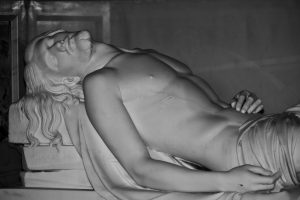ARCHIVAL MOMENT
“Representing himself to be another … Philip Dohey and Charles Foley”

Photo Credit: The Rooms Provincial Archives: LS 51; S.S. Bellaventure crew bringing bodies and survivors of the S.S. Newfoundland Sealing Disaster aboard ship.
One of the men that died in the Sealing Disaster of 1914 was Charles Foley of St. Bride’s, Placentia Bay. The irony was that Charles Foley did not have a berth on the S.S. Newfoundland; his name is NOT listed in the Sealers Crew Agreement.
The oral tradition in St. Bride’s was that Philip Dohey was one of the crew on the S.S. Newfoundland but at the last minute gave his berth to his friend Charles Foley. This “personating or representing himself to be another” was frowned upon, so much so that the Agreement signed between Captain Wesley Kean of the S.S. Newfoundland and Philip Dohey on March 4, 1914 read:
“If any man should sign a false name not his own and shall proceed in the said vessel personating or representing himself to be another, it shall be the option of the masters or suppliers to withhold from him any share of the voyage.”
His determination to find a berth on the S.S. Newfoundland to the extent that he would “represent himself to be another’ may have been a commentary on the economy of the day. The seal fishery represented the only source of cash income that would transition their families from the long winter into the approaching summer fishery.
Between March 31 and April 2, 1914 disaster struck. The men of the S.S. Newfoundland found themselves on the ice, stranded in a blinding snowstorm with freezing temperatures. In the 54 hours they were stranded, many died.
The local paper the Evening Telegram in St. John’s reported in April 1914 about the bodies being removed from one of the rescue vessel, the S.S. Bellaventure that had pulled into St. John’s Harbour.
“The vision sent a shudder through the crowd. The bodies had been laid there just as they were brought in from the ice, many of them with limbs contracted and drawn up in postures which the cold had brought about.”
The task of identifying the 69 dead and 8 missing men was given to Dr. Alexander Campbell, the port doctor in St. John’s. Using the Sealers Agreement register, Dr. Campbell declared crew member #78; Philip Dohey missing.
It was not until April 30, 1914 that authorities confirmed that crew #78 was in fact not Philip Dohey but Charles Foley.
Crew #78 was the last of the 78 men declared dead.
Officially the Sealers Crew Agreement, now held at the Rooms Provincial Archives continues to read, Philip Dohey missing.
Philip is not known to have spoken about giving up his berth on the S.S. Newfoundland to his friend. No doubt he pondered what fate had been dealt to him.
Charles Foley is not in the official register but he is remembered at the “Home from the Sea, Sealers Memorial” in Elliston, Trinity Bay where all those who lost their lives prosecuting the seal fishery in the spring of 1914 are engraved on a stone tablet.
Recommended Archival Collection: At the Rooms Provincial Archives see GN 121 this collection consists of the evidence taken before the Commission of Enquiry regarding the S.S. Newfoundland. The collection includes the Sealers Crew Agreement and the evidence given by the surviving members of the crew. Evidence entered concerning the loss of the SS Southern Cross is also included on this collection.
Recommended Exhibit: The National Film Board’s documentary 54 Hours written by Michael Crummey, using animation, survivor testimony and archival footage. You can also view the short film from your own home at https://www.nfb.ca/film/54_hours
Crew List: In the days and months following the loss of the S.S. Southern Cross and the tragedy of the loss of the men of the S.S. Newfoundland there was much confusion about the names and the number of men that did die. You will find the definitive list of all those that did die as well as the survivors at http://www.homefromthesea.ca/
Recommended Reading: PERISHED by Jenny Higgins (2014) offers unique, illustrative look at the 1914 sealing disaster through pull-out facsimile archival documents. More than 200 rarely seen archival photos and documents illustrate this amazing book.
















